
Where To Find An Office In My Home?
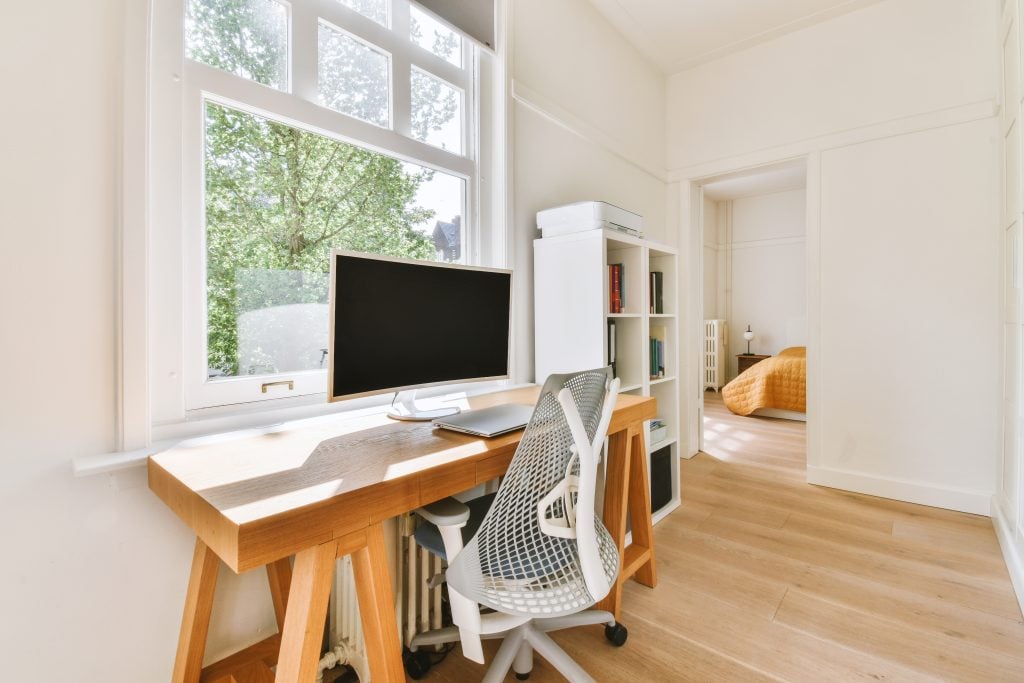
Working from home is becoming increasingly popular in the UK. But where should you set up your office? The rise of home offices has made it essential to find the right spot in your home to boost productivity and comfort.
An ideal world might grant everyone a spare room to convert or allow for a purpose-built extension, but that’s not always feasible. In this article, we’ll explore creative design tricks and storage solutions to help you create an effective office area, even when space is limited.
Firstly, consider the function of your rooms. It’s much better for your mental health to have a physical barrier between your work area and your ‘home’ life.
This means avoiding setting up a permanent office area in your bedroom or lounge—places traditionally used to ‘get away’ from work and relax. If you can always see your workstation, it’ll be a constant reminder of unfinished projects or tasks.
Keeping your work and relaxation areas separate helps maintain a healthy work-life balance. Now, let’s delve into the specifics of finding the perfect office space in your home.
Finding A office Location
Here are some simple questions to ask yourself to help determine the best location for your office space:
- How much will this work space interfere with my home life. That will I always be able to see my workstation or can I hide it away/put a physical barrier in place when the work day’s ‘done’?
- Can this space be set up to limit external noise, distractions and interruptions as much as possible?
- Is there enough natural/artificial light? (It might be worth installing circadian rhythm lighting if you’re going to be spending a lot of time under artificial lights)
- Will the view inspire and motivate me or be a distraction?
Once you’ve decided where would be the best location for your work space. The next step is to find an office setup that works with the existing design of the room.
It’s much better for your mental health to have a physical barrier between your work area and your ‘home’ life.
- Yoop Architects TWEET THIS
Small Space Office Solutions: Maximize Functionality in Limited Areas
Limited square footage doesn’t have to limit your home office dreams! Here are some creative solutions to carve out a productive workspace even in the most compact corners:
Office Cupboard
Repurpose a wardrobe, large cabinet, or secretary desk as a multifunctional office cupboard. This provides both storage and a work surface, and hides away neatly at the end of the workday. Keep in mind legroom limitations; consider a pull-out keyboard tray for added comfort.
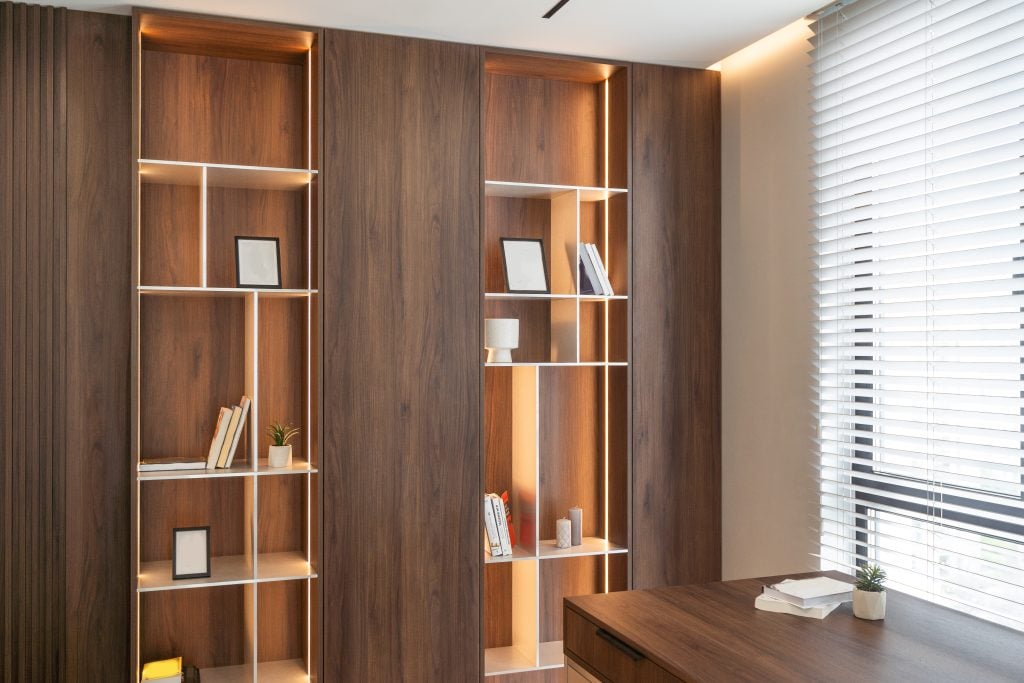
The advantage of using office cupboards is that at the end of the day, you can simply shut the doors. The disadvantage is that they don’t usually offer much leg room but you could install a pull out keyboard tray to give yourself a more comfortable working area.
Inside this easy to read free guide, we will teach you the 6-steps that we use to help our clients achieve their dream home improvements.
Wall Mounted Unit
For a space-saving option that folds away when not in use, consider a fold-down unit or wall-mounted desk. These ingenious solutions offer a designated workspace without sacrificing valuable floor space.
Fold-Down Desk office: Tiny Space, Big Productivity
Live small, work big with a fold-down desk! This space-saving hero transforms your wall into a workstation when needed, then disappears when the workday’s done. Choose a size and style that suits for your office, and conquer limited square footage without sacrificing productivity.
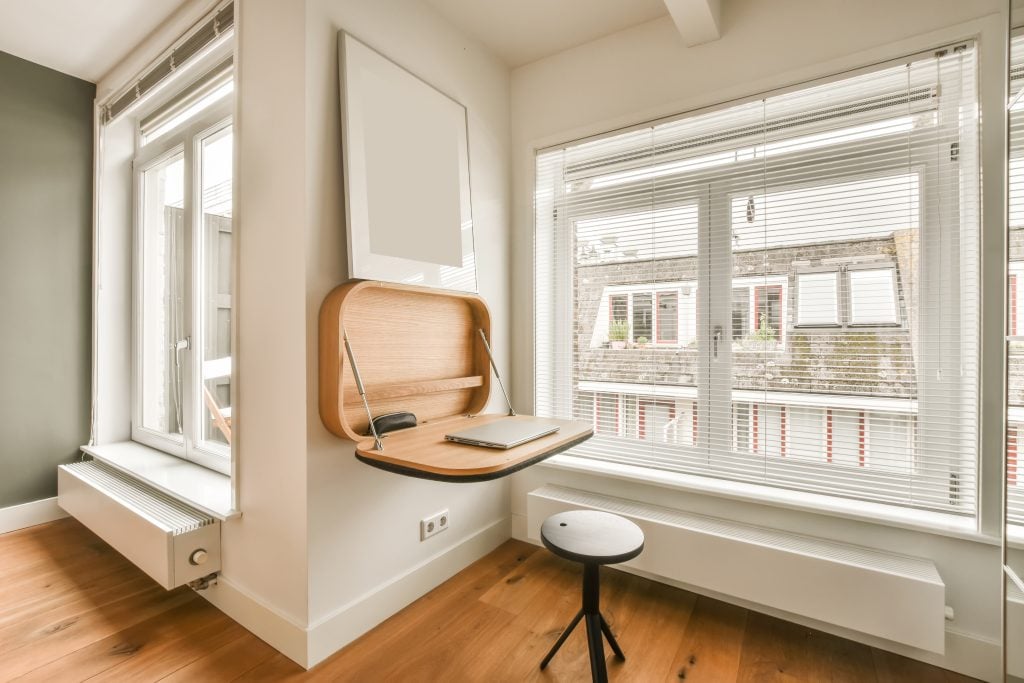
Wall-Mounted Desk: Float Your Way to Productivity
Forget bulky furniture! Wall-mounted desks offer a sleek and space-saving solution for your home office. These floating beauties free up floor space, creating an airy feel. Perfect for small areas, they fold up or disappear completely when not in use. Choose from a variety of styles to match your décor and float your way to a clutter-free, productive workspace.
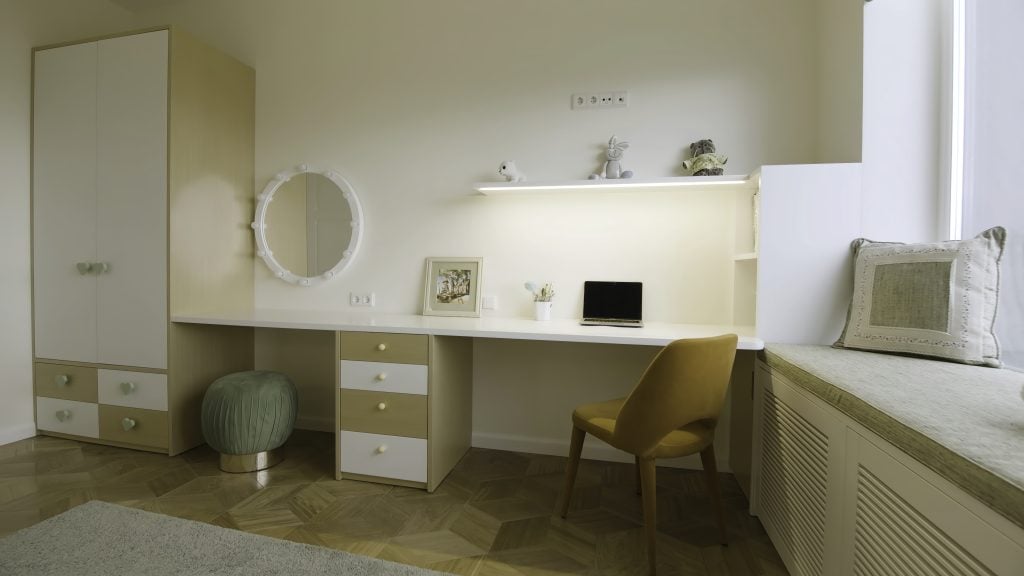
Share this...
Unused Space for office
Another solution may be to consider whether there are any nooks and crannies or little awkward spaces in your home that you’re not using – perhaps some closet space or room under the stairs? They may seem a bit cramped and dingy at the moment but the right decor and lighting can completely change the feel of the space.
Room Dividers
If it’s not possible to avoid setting up a workspace that will constantly be visible in an area of your home such as your bedroom/lounge then it’s worth investing in a simple room divider/privacy screen to separate your work area from your ‘home’ life.
If you have any questions about finding an office space in your home, or just questions about creating your dream home in general, go ahead and book a free call below with Yoop.
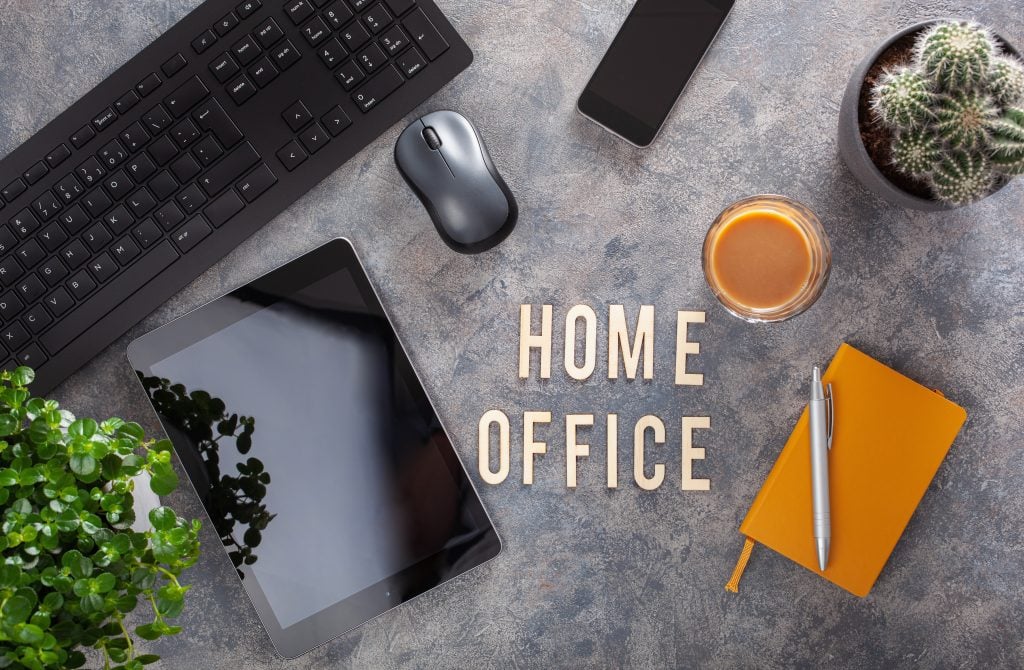
Assessing Your Space
When looking for the perfect office spot, start by evaluating the available rooms or corners in your home. Unused spaces like guest rooms, attics, basements, or even garden sheds can be transformed into functional office areas. It’s essential to consider the size requirements for a comfortable office setup. You’ll need enough space for your desk, chair, and any necessary equipment.
Storage is another crucial factor. Assess your storage needs and see if the space can accommodate shelves, cabinets, or other storage solutions. Sometimes, clever use of vertical space can help maximise storage in a smaller area. In addition, think about multifunctional furniture that can serve both your office and general home needs.
Finally, it’s crucial to ensure that your chosen space doesn’t intrude on areas where you relax or socialise. For instance, setting up in the dining room might seem convenient but could disrupt family meals. A clear division between work and personal areas helps maintain productivity and relaxation.
Light and Noise Considerations
Natural light plays a significant role in boosting productivity and maintaining a positive mood. When choosing your office space, try to pick an area with ample natural light. If you have a window, position your desk nearby to take advantage of daylight. Additionally, using light-enhancing décor, like mirrors or light-coloured walls, can help brighten the space.
Noise levels are another important consideration. Identify quiet areas away from household activity. Setting up near a busy kitchen or living room can be distracting. If complete silence isn’t achievable, consider soundproofing options. You can use thick curtains, rugs, or even acoustic panels to reduce noise.
Moreover, using noise-cancelling headphones or white noise machines can help create a quieter work environment. Ensuring a peaceful workspace enhances focus and productivity. Remember, a well-lit and quiet space is key to a successful home office setup.
Comfort and Ergonomics
Comfort and ergonomics are crucial for maintaining health and productivity. Choosing the right furniture is vital. Invest in an ergonomic chair that supports your back and promotes good posture. A suitable desk that accommodates your work equipment without causing clutter is equally important.
Temperature control is another aspect to consider. Your office space should maintain a comfortable temperature. Use heaters or fans as needed to ensure a pleasant working environment. Over time, sitting in an uncomfortable setting can lead to health issues like back pain or eye strain. Therefore, it’s worth taking the time to create a comfortable and ergonomic office setup.
Finally, consider adding personal touches that make the space inviting. Plants, artwork, or photos can make your office feel more personalised and enjoyable to work in. A comfortable and ergonomic office is not just about productivity but also about creating a space where you enjoy spending time.
Connectivity and Technology
A strong and reliable internet connection is essential for a home office. Ensure that your chosen space has a robust Wi-Fi signal. If the signal is weak, consider using Wi-Fi extenders or mesh systems to boost connectivity.
Electrical outlets are another crucial factor. Make sure there are enough power outlets to accommodate your equipment. Using extension leads and power strips can help manage your electrical needs. It’s also important to organise cables properly to prevent clutter and potential hazards.
In addition to basic connectivity, think about your technology needs. Ensure your office has the necessary equipment, such as printers, scanners, or any specialised devices. Properly setting up your technology ensures smooth workflow and minimises disruptions.
Personalisation and Aesthetics
Creating a motivating environment is key to a productive home office. Personal touches like artwork, plants, and personal photos can make the space feel inviting and uniquely yours. Use colours and décor that you find inspiring and energising.
Organisation is also important. Keeping your office tidy and organised enhances productivity. Use storage solutions like shelves, cabinets, and organisers to keep everything in place. A clutter-free workspace helps maintain focus and efficiency.
Moreover, consider the aesthetics of your office. A well-decorated space can boost your mood and make working from home more enjoyable. Remember, a personalised and aesthetically pleasing office can significantly impact your productivity and well-being.
Legal and Practical Considerations
When setting up a home office, it’s essential to consider any legal and practical implications. Check if any planning permissions or building regulations apply to your office setup. For example, converting a garage or attic may require permission from your local council.
Home insurance is another consideration. Ensure that your home insurance covers your office equipment. Some policies may need to be adjusted to include business use of your home.
Safety measures are crucial. Ensure that your office is set up safely to avoid accidents. Check for potential fire hazards and ensure electrical safety. Regularly inspect your setup to maintain a safe working environment. Legal and practical considerations are essential to ensure a smooth and trouble-free home office setup.
So, where can you find an office in your home? The answer is: almost anywhere!
With a little creative thinking and space-saving solutions, you can transform a spare nook, an underused corner, or even a closet into a functional and inspiring home office.
Remember, the key is to prioritize both practicality and separation from your living space. With these tips, you can carve out a productive haven that maximizes your focus and minimizes clutter, no matter the size of your home.
FREE EXPERT HELP TODAY
Thinking of your dream home improvement or how to start your project?
Need your planning questions answered? Talk to an expert today.
Book a FREE 20 Minute Call with one of our home improvement Architects.


